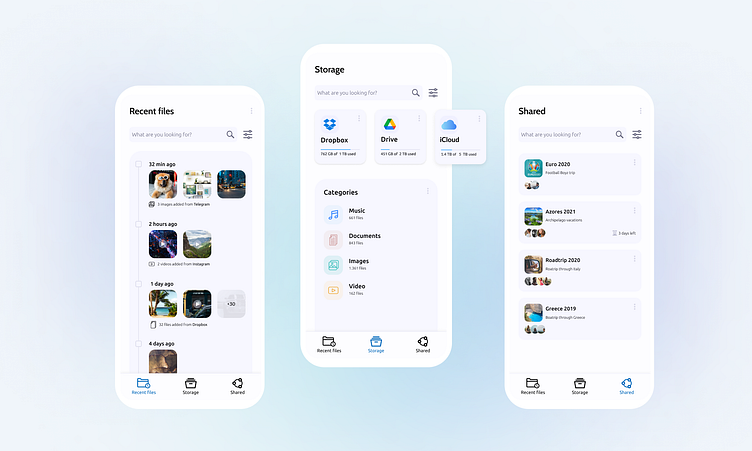Cloud storage unifier
Finding a specific file on the go is never easy. On some devices might be easier, for example, using spotlight feature but if you don’t know the name of the file it’s a tough task. The idea of this case study is to explore a solution for this issue with file management.
Finding the problem
Nowadays we have various sources of files. Be it from different social media platforms, device captures, downloads, emails, cloud solutions, etc… It might have happened to you to have difficult time finding a specific document which you don’t know the exact name it has. Or finding a photo you’ve taken on holidays with friends that have the exact same group on different social media platforms…
So the recurrent theme of these scenarios is the lack of centralisation and customisable categorisation, to have one single source of managing your files the way you feel more comfortable with. Another use case, would trying to find a document to which you don’t know the name, for example files generator from online services platforms, like medical exams, invoices, etc
Defining the problem
Lack of file centralisation
Categorisation to app folders
Elastic Search feature
Onboarding
The focus here is to clarify on the problem this application proposes to solve. Stating the main problem in a marketing perspective, in order to captive the user of the product. Putting centralisation first and foremost, the product would turn out to be the central point to access and find any files you’ve ever had ownership.
Experience
Set up your account, connecting the cloud storage solutions you have and also have allow access to your email so you can integrate email based file sharing (e.g.: WeTransfer). Making the product connected with all your file storage solutions and also ones shared with you, hence making it your doorway to manage them and quickly find them on the spot. Using Artificial Intelligence to quickly figure out the elements files contain, for example, you need to find a photo for a tree you’ve planted in March last year, using Deep learning models like GPT-3, this would enable you to find the image via filtering with simple parameters using elastic search. Making the most out of this to create automatic folder categorisation for the user, but also allowing the user to customise their own.
The product would be split in three main tabs, first one is dedicated to categorisation of your files and cloud storages; second one is focused on the most recent files that were processed either by your phone or by connected third party applications or cloud storage; third tab is dedicated to the files that were shared with you via cloud solutions, with a feature that would let you know if you have a limited amount of time to access these files, prompting either a notification in app (via a dot to let you know there were changes to this, or phone notification, if you have them on), allowing the user to see a timer in changed access, and backing up those documents elsewhere. The core experience of this product is to have reduced cognitive effort when finding and managing files, but also promoting clearer mind, not only through the features available as well as visually having a clean and simple user interface.
End goal
Managing to achieve these three goals, there were some concerns that were raised during this study. One was the user concern for the privacy of their data, which would have to be thought out with care from a technical development standpoint. Also the way to connect all these third party applications and cloud solutions to this product would be a hard task to achieve.


